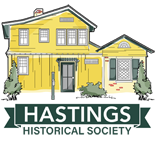The Historical Society hosts annual exhibits on local history, with each exhibit opening in the fall and running through Hastings High School Alumni Weekend the following September.
Over the years, the subjects of our exhibits have ranged from notable residents and local industries to our schools and civic organizations.
We make use of our database of over 12,000 photographs, our numerous artifacts and our extensive archive to make Hastings’ history come alive. We welcome donations of materials related to the history of Hastings.
UNBUILT HASTINGS: WHAT MIGHT HAVE BEEN

2022–2023
Unbuilt Hastings: What Might Have Been describes some projects in our village that were proposed but never built. Ranging from a plan in the 1930s to expand a hospital in today’s Hillside Park, to a 1960 urban renewal project on Warburton Avenue, and ideas for our yet-to-be developed waterfront, we cover a number of “what might have beens.” We leave it for the visitor to decide if these projects would have enhanced or detracted from life in our village.
Exhibition Curators
Natalie Barry
Annette Selvaggio Borowitz
Judy Chamberlain
Jan Clough
Eileen Forbes-Watkins
Claudia Gisolfi
Cookie Kashmanian
Ginny Kazura
Beth Smith
Sue Smith




HASTINGS WAY BACK WHEN, THEN AND NOW: 13 ICONIC VIEWS

2021–2022
Hastings Way Back When, Then and Now: 13 Iconic Views featured 13 familiar spots in Hastings photographed three times: circa 1930, circa 1990, and again in the present day. Each of the selected images showed either an important historic site and/or a view in our village that has changed significantly over the years. A description and history of the site accompanied each set of images.
Details coming soon.

2018–2019
This was the third of three exhibits devoted to the exploration of the history of our village, starting in the 1940s and continuing to the present day. It began with a look at Hastings during WWII, then covered the development of our newer neighborhoods in the 1950s and 1960s. We then took a trip down memory lane to recall some of our favorite businesses and eateries over the past 70+ years.
The exhibit began with a look at Hastings during WWII and the development of the last remaining open tracts of land in 1950s and 1960s. We then recalled many of our favorite businesses and eateries, and profiled some of the interesting and important people who have made Hastings their home during this time frame. We also took a look at the involvement by our residents in local organizations and village committees, paying homage to those who devote time and energy to their community.


GROWING HASTINGS: THE NEIGHBORHOODS EMERGE

2017–2018
This was the second of three exhibits on the history of the village, which spanned the years 1900 to 1939, just prior to World War II. This period saw the transformation of several 19th century farms and estates into a number of Hastings’ residential neighborhoods, including Riverview Manor, Hudson Heights, Pinecrest and Shado-Lawn. Visitors to the exhibit learned how these areas within our community came to be, as well as about daily life in the village and about many of the accomplished and influential people who lived here during that time.
This is part two of three years of exhibits on village history covered the years from 1900 to the eve of World War II. This period that saw the transformation of several 19th century farms and estates into a number of Hastings’ residential neighborhoods, including Riverview Manor, Hudson Heights, Pinecrest and Shado-Lawn. Visitors learned how these areas within our community came to be, about daily life in the village and about many of the accomplished and influential people who lived here during that time.


GROWING HASTINGS: THE EARLY YEARS

In this exhibit, the Hastings Historical Society brought to life the early years in the formation of our home along the banks of the Hudson River. Our exhibit followed the evolution of Hastings from home of the local Lenape Indians, the Weckquaesgeeks, through the arrival of the Dutch in the early 1600s and the division of our area into four tenant farms owned by the Phillipse family. We then looked at the village during and after the American Revolution, tracing the growth of waterfront industries and the early neighborhoods downtown and along Warburton Avenue and in Uniontown. The exhibit also looked at some of the large estates that dotted the village during the 19th century, as well as some of the people who owned them. A time-line of world events ran throughout the exhibit, placing local events in context to what was happening in the wider world.


Hastings First Responders: Our Heroes Through the Years

In this exhibit we traced the history of each of the village’s four fire companies, as well as the ambulance corps and the police department. Included were trophies, awards and numerous old photographs.
Honored were the companies of
• Protection Engine Company 1, founded January 13, 1876
• Uniontown Hose Company 2, founded August 21, 1899
• Riverview Manor Hose Company 3, founded in 1910
• Hook and Ladder Company 1, founded April 20, 1934
• Ambulance Corps, organized in 1955



Picturing Hastings

The Historical Society’s first juried photo competition, entered by both amateur and professional shutterbugs of all ages, produced numerous photographs that enrich our vast collection. Below are six of our prize winners in various categories.






Hastings Artists: A Rich Legacy

The exhibit included paintings, sculpture, folk art and furniture. Some of the more widely known artists represented included George Harvey, Jasper Cropsey, and Jacques Lipchitz. The show also included pieces by local favorites such as Debbie Gaynes, Allen Grant, Margaret Kennedy, Mary McIntyre, Winifred Murphy, John Raible, Helen Patterson Williams, and many others.
The show also included pieces by local favorites such as Debbie Gaynes, Allen Grant, Margaret Kennedy, Mary McIntyre, Winifred Murphy, John Raible, Helen Patterson Williams and many others.



Hastings Serves: At Home and Abroad

The Hastings Serves exhibit featured photos and memorabilia from World Wars I and II, as well as the Korean and Vietnam Wars, and spotlighted several Hastings families and veterans. The visitor viewed uniforms, medals, ration books, soldiers’ letters and numerous other artifacts from our collection.
A special feature of the exhibit was 15 portraits of Hastings men and women who served our country, photographed by members of the Hastings High School Photography club under the direction of their adviser, Marty Merchant.




Hidden Treasures from the Society’s Collection

2011–2012
The Hastings Historical Society displayed never-before or rarely-seen artifacts from our collection. These included a wooden bowling set from the 1890s given to us by the Draper family, a wooden ballot box, various items that belonged to long-time resident and business woman Josephine Dos Santos, a school desk from the St. Matthews School, and an assortment of old greeting cards.
These included a wooden bowling set from the 1890s given to us by the Draper family, a wooden ballot box, various items that belonged to long-time resident and business woman Josephine Dos Santos, a school desk from the St. Matthews School, and an assortment of old greeting cards.
A Story of a Village: Hastings in Maps from 1600 to the Present

Among the maps displayed highlights included a 1932 “Historical Map of the Westchester County” by Hastings cartographer John P. Davies, and three maps from a 1889 insurance atlas of Greenburgh.
A Year of Celebrations

The year 2009 marked the 400th anniversary of the historic voyages of Henry Hudson and Samuel Champlain through the river and lake that bear their names, as well as the 200th anniversary of Robert Fulton’s steamship voyage on the Hudson River. Items on display included commemorative medals, postage stamps and flags, as well as photographs of the 1909 Hudson-Fulton celebration parade held in the village. CLICK TO LEARN MORE.
The Literature Club was founded in 1909 and its by-laws stipulated that the members must live in the village, be female and must be serious readers. The Historical Society houses over 100 years of the club’s minutes, program books and photographs. Many were on display. CLICK TO LEARN MORE.
The Riverview Manor Hose Company No. 3 was founded in 1910 and the exhibit commemorated their 100th anniversary using photographs and memorabilia from our collection.


MILESTONES IN ASTRONOMY: THE DRAPERS OF HASTINGS-ON-HUDSON

2009 was the 400th anniversary of Galileo’s use of the telescope to study the stars, and it was declared an “International Year of Astronomy” by the International Astronomical Union and UNESCO. John William Draper took what are considered to be the first successful astronomical photographs – daguerréotypes – of the moon in the winter of 1839-40. In the 1860s, his son, Henry, took photographs of the moon through a telescope that, for many decades, remained unsurpassed in clarity and detail. LEARN MORE HERE AND HERE


School Days, School Days: A Historic View

The Hastings Historical Society featured photographs, artifacts, student publications, schoolbooks and yearbooks from our vast collection to look at our public schools over the years. TO LEARN MORE.



Anaconda in Hastings: 1929 to 1975

The exhibit included nearly a hundred photographs and dozens of artifacts, among them:
• a picture gallery of Anaconda workers,
• a guide to the factory buildings,
• a step-by-step depiction of how copper cable was made,
• a round-up of company social events that included its baseball and bowling teams,
• a photo-essay on Anaconda’s landmark water tower, and
• a look into the High Energy Laboratory with its lightning-making machine.
On display was the company’s old employee suggestion box (built to resemble one of the most distinctive factory buildings), models of laboratory equipment, cable samples, and a Lionel Train flatcar carrying Anaconda cable reels. Also included was a regular showing of a 1950s Anaconda promotional film made to showcase the Hastings plant. The exhibit ended with a look at the dramatic events that accompanied the plant’s closing in 1975.


Two Women’s Views: The Artwork of Helen Patterson Williams and Winifred Murphy

Helen Patterson Williams was an established commercial artist when she moved to Hastings from Boston in 1907 with her new husband, Herbert Deland Williams, also an artist. She specialized in Arts and Crafts-style jewelry and interior decoration. Allergic to oil paint, Mrs. Williams worked mostly in watercolor and tempera; her many views of the Hastings landscape and waterfront have a distinctive mellow hue. She was also a prolific producer of illustrated and illumined social invitations, many of which contained local scenes.
Apart from her finely detailed pen-and-ink drawings, Winifred Murphy is probably best remembered as a long figure walking up and down the hills of Hastings. Hers was a solitary life often punctuated by illness. Her walks through the village became part of her recovery and then a path to a new career: she began making and selling pen-and-ink drawings of private houses in the area, many of them still cherished by the homes’ owners. Her work also included wood block printing, textiles and decorative wallpaper friezes, and abstract oils.









